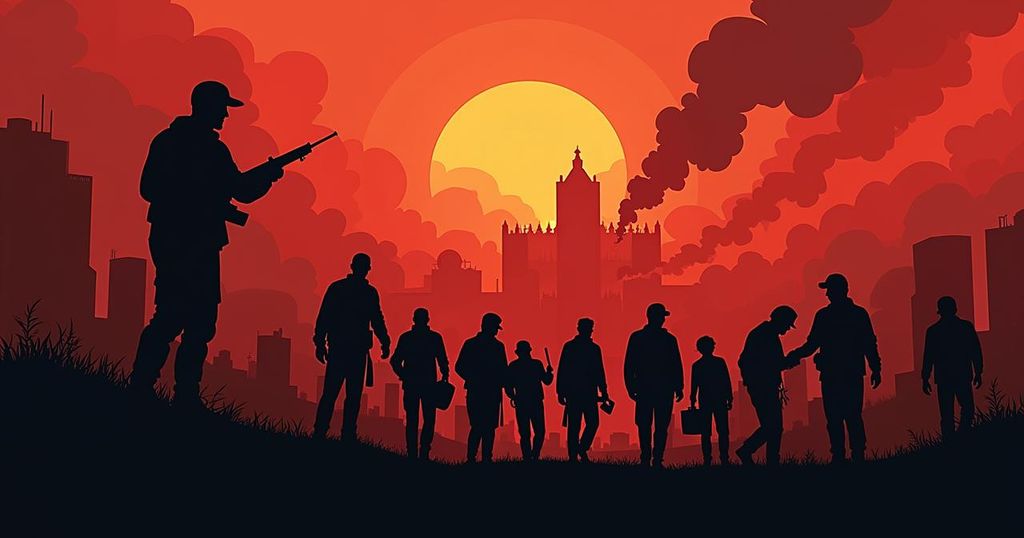Armenia’s Velvet Revolution: From Hope to Disillusionment After Nagorno-Karabakh Conflict
Armenia’s 2018 Velvet Revolution, marked by optimism and reform, has succumbed to sorrow following a catastrophic defeat in Nagorno-Karabakh. The conflict claimed over 2,300 lives and resulted in significant political backlash against Prime Minister Nikol Pashinyan, transforming public perception of him from a hero to a perceived traitor. As the country faces a humanitarian crisis and looming economic challenges, political unrest is mounting, reflecting deep disappointment among citizens who once rallied for change.
Armenia’s political landscape has shifted dramatically following a devastating military defeat in Nagorno-Karabakh at the hands of Azerbaijan. The conflict, which resulted in over 2,300 Armenian casualties, has severely undermined the public’s support for the reformist government led by Prime Minister Nikol Pashinyan, marking a stark contrast to the optimism that characterized the 2018 Velvet Revolution. In the aftermath of the conflict, the once-celebrated revolution has given way to despair and national mourning. Many citizens, including young soldiers and refugees from Nagorno-Karabakh, navigate through a somber Yerevan, grappling with their losses and seeking assistance from international allies. The jubilance of the Velvet Revolution, which saw masses rally to displace a decades-long autocratic regime, now feels like a distant memory overshadowed by grief and hopelessness. Initially, there was tremendous excitement surrounding the revolution, spearheaded by Pashinyan, a former journalist who emerged as a symbol of hope against corruption. His government promised a new era of democracy and transparency. However, the recent war shattered these aspirations, shifting the national focus to the traumatic consequences of defeat. Instead of pursuing further reforms, the population is now confronted with a humanitarian crisis, absorbing approximately 100,000 refugees and battling a severe health and economic crisis exacerbated by COVID-19. Pashinyan’s declaration of a ceasefire, which effectively conceded victory to Azerbaijan, has turned him from a revered leader to a figure of scorn, branded a “traitor” by sections of the populace. As political unrest stirs, opposition movements are gaining traction, demanding Pashinyan’s resignation as the call for early elections grows louder. Despite his efforts to maintain stability and outline a roadmap for governance, Pashinyan faces deep skepticism from those who once supported him. Discontent is palpable among the youth, many of whom took to the streets during the revolution, and their sense of betrayal has rekindled fears of a return to the previous regime. While the opposition struggles to mount mass protests comparable to those of 2018, there remains a potent undercurrent of frustration among the citizenry, complicated by a lingering fear of former leadership. Young activists express a mix of admiration for Pashinyan’s initial vision and disappointment over his handling of the conflict. Current perceptions of Nagorno-Karabakh as an integral part of Armenia only intensify their frustration. As Armenia confronts an uncertain future, economic projections indicate an impending crisis, with poverty rates expected to rise steeply. The government must address a mounting refugee influx and the consequences of its military defeat while navigating a fragile political environment, which complicates the pathway toward recovery.
The Velvet Revolution in Armenia, which occurred in April 2018, was a peaceful uprising that resulted in the ousting of the corrupt government led by Prime Minister Serge Sarkissian. This transformative movement was driven largely by the youth and saw Pashinyan rise to prominence as a reformist leader promising a more democratic and transparent government. However, the recent conflict in Nagorno-Karabakh against Azerbaijan represents a significant setback for the revolution’s ideals, leading to widespread disillusionment among the populace and a crisis in national unity. The struggle over Nagorno-Karabakh, a region with a majority ethnic Armenian population, has been a longstanding source of tension between Armenia and Azerbaijan. This conflict resurfaced in September 2020, culminating in a 45-day war that ended with a ceasefire agreement favoring Azerbaijan, further complicating Armenia’s political landscape and triggering a humanitarian crisis characterized by high casualties and a refugee influx.
In conclusion, Armenia’s Velvet Revolution, which once inspired hope and optimism for progress, has been overshadowed by the profound implications of a military defeat in Nagorno-Karabakh. As citizens grapple with loss, disillusionment, and an uncertain future, the leadership of Prime Minister Pashinyan faces increasing scrutiny and pressure. The combination of a humanitarian crisis, an impending economic downturn, and rising political tensions poses substantial challenges that will shape Armenia’s trajectory in the coming years. The road ahead is fraught with difficulties as the nation reflects upon the harsh realities of leadership, identity, and the sacrifices made in the quest for independence and stability.
Original Source: worldcrunch.com




Post Comment